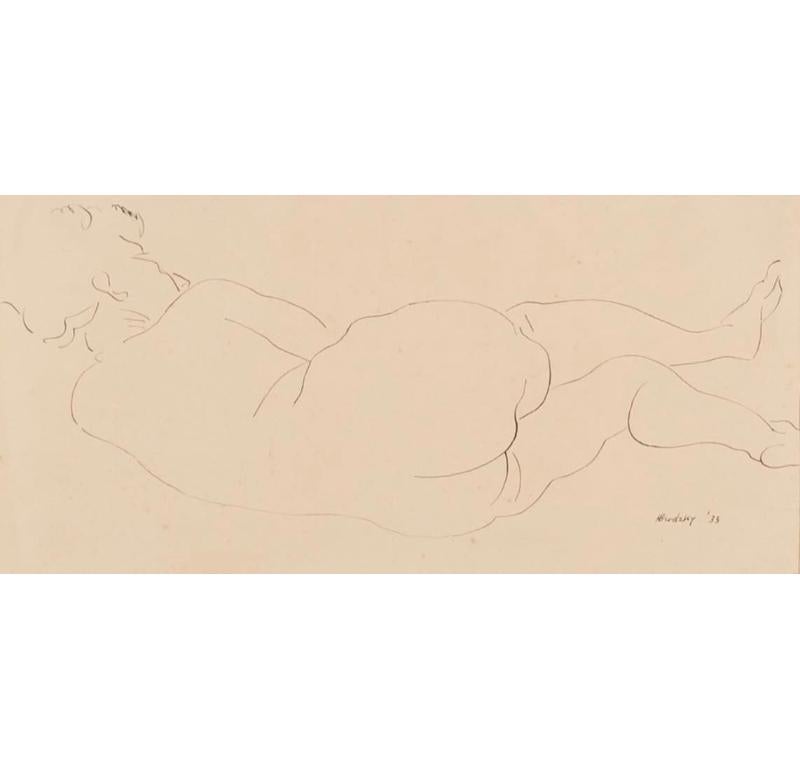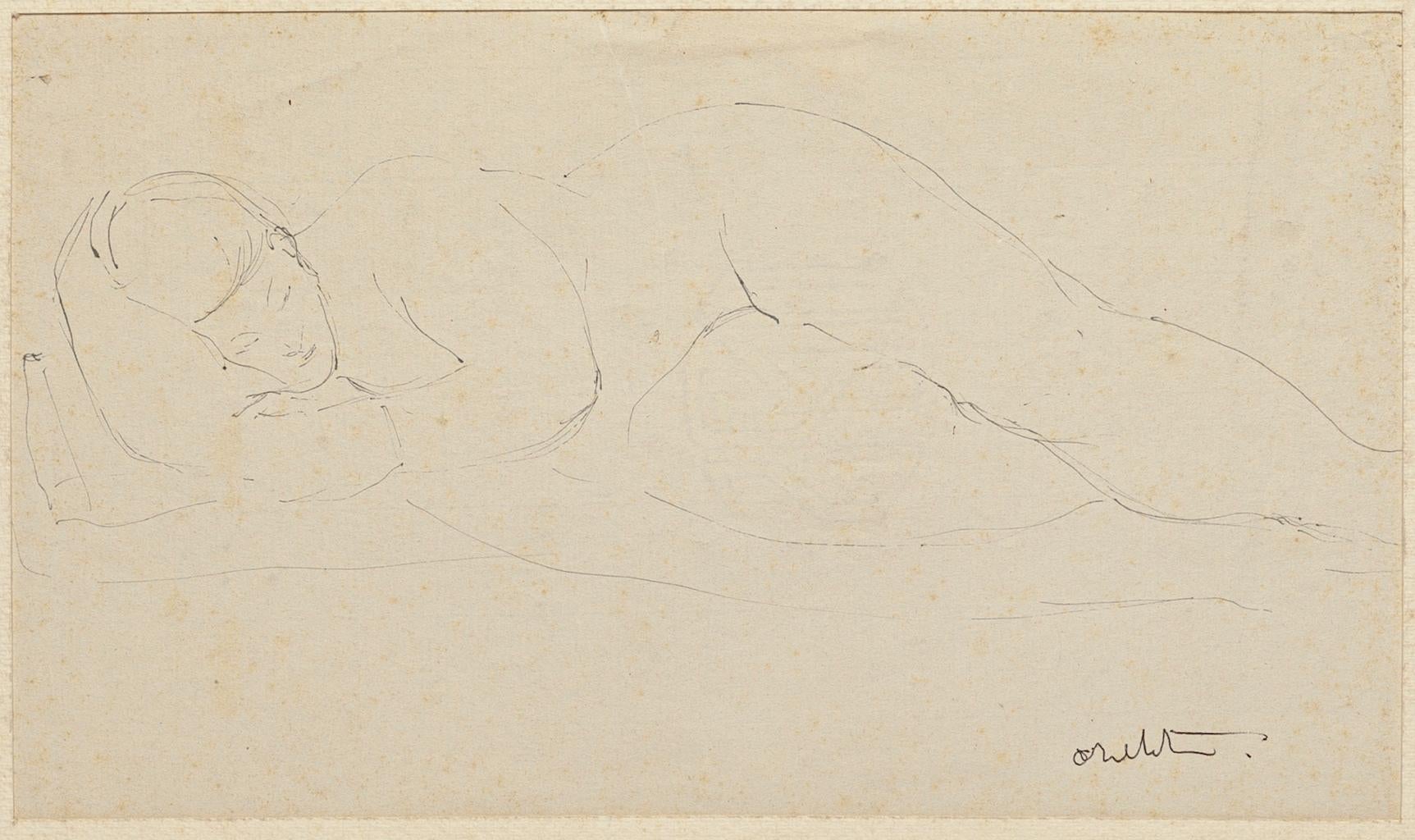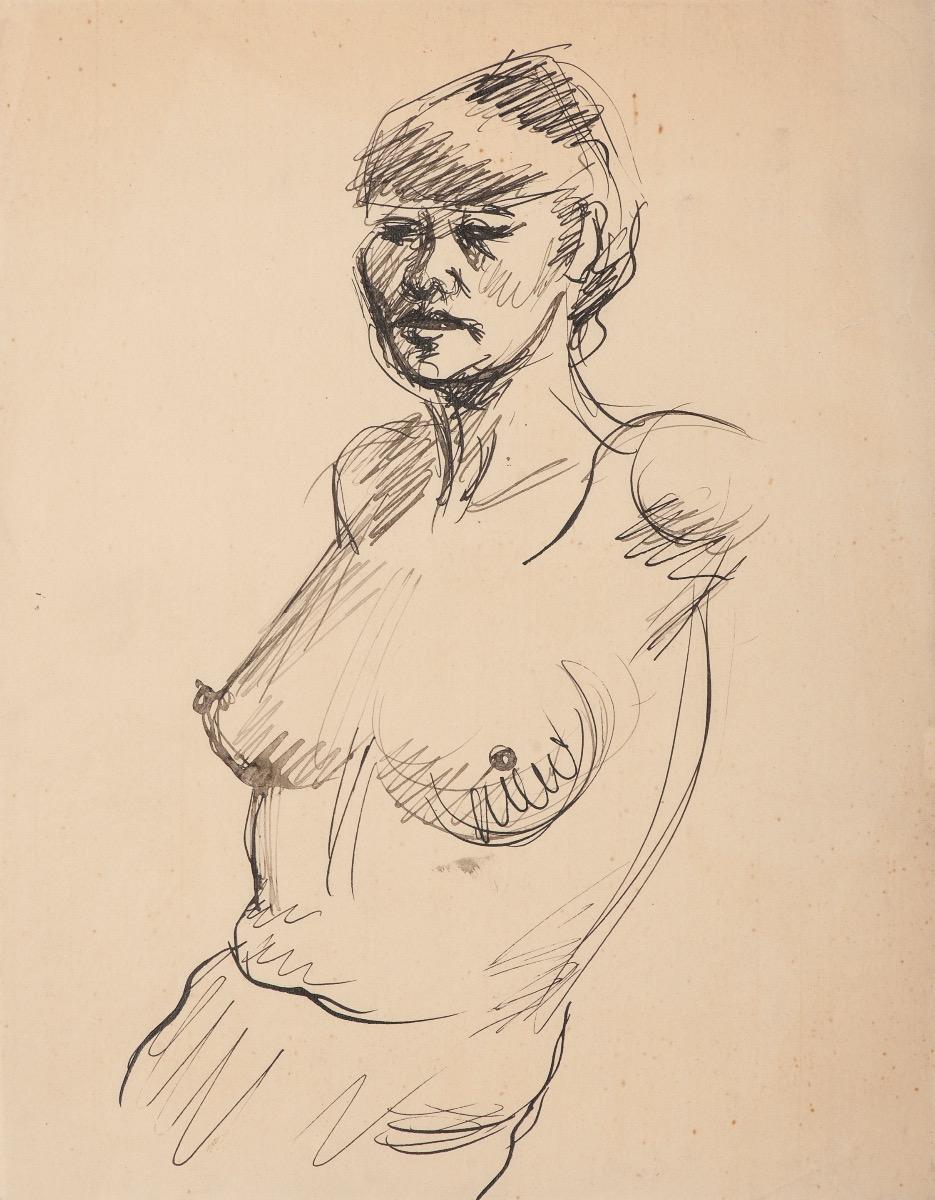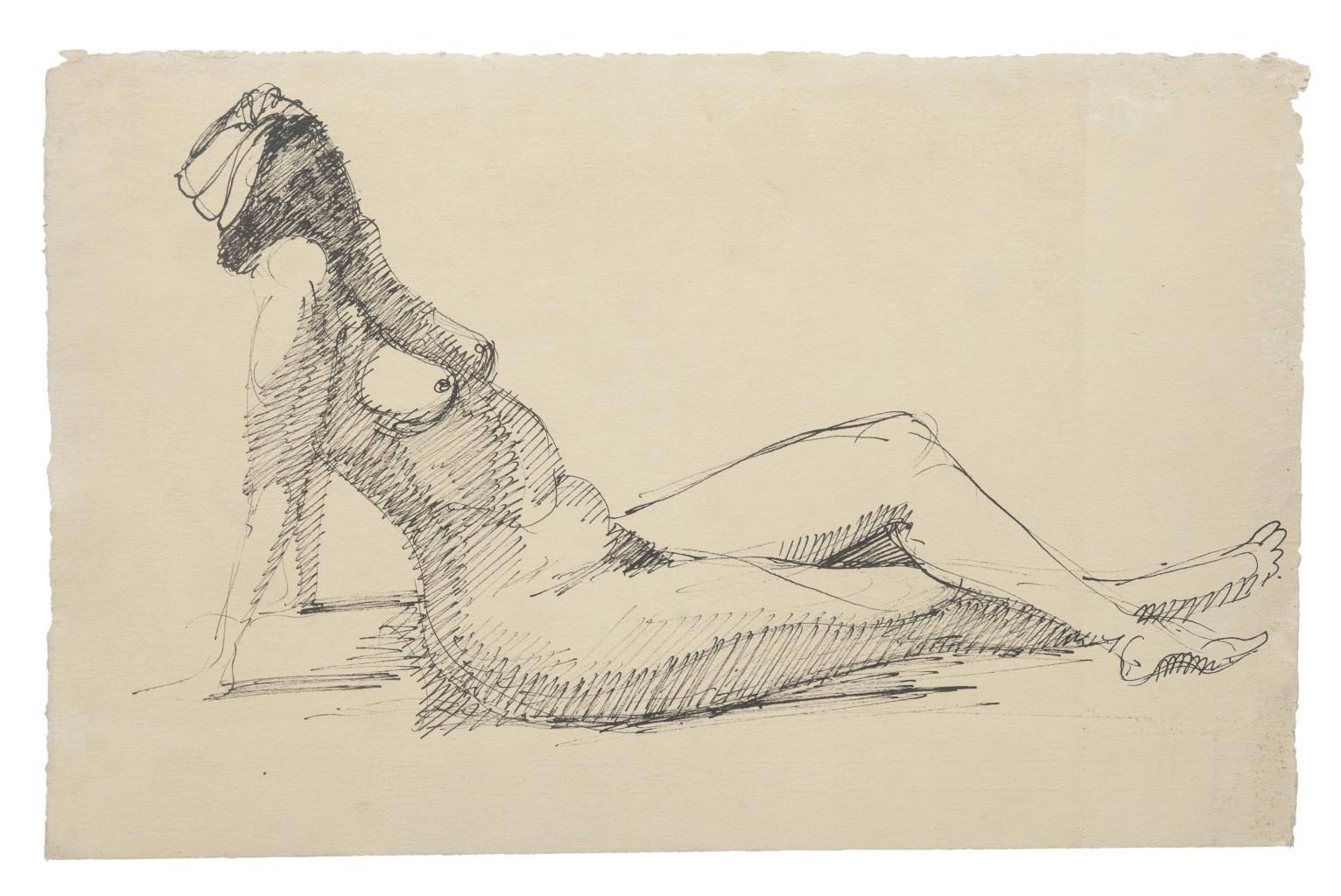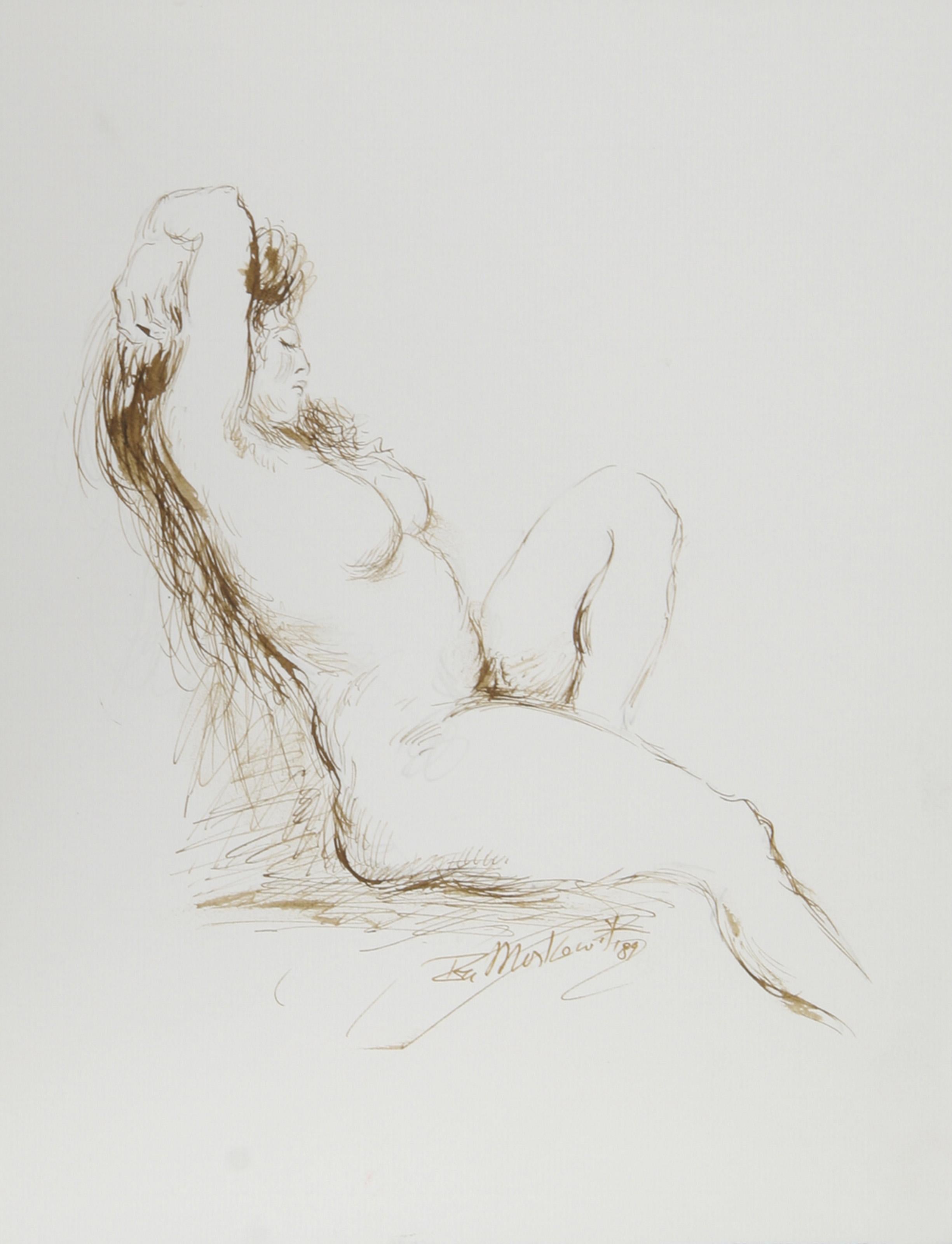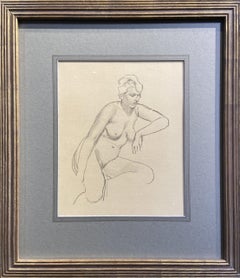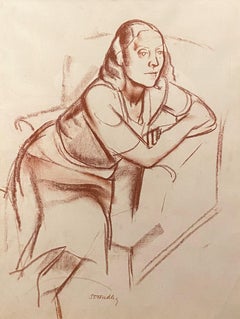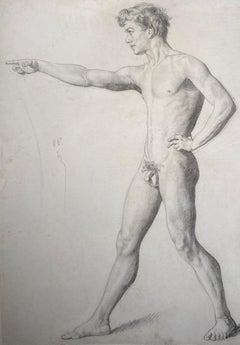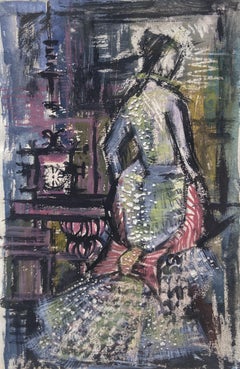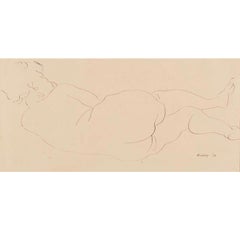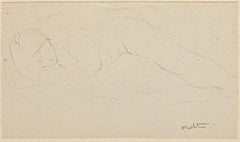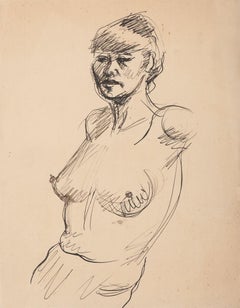Items Similar to Essence of Line, Ink Nude Study, Early 20th Century Drawing, Signed and Dated
Want more images or videos?
Request additional images or videos from the seller
1 of 3
Horace BrodskyEssence of Line, Ink Nude Study, Early 20th Century Drawing, Signed and Dated1934
1934
Price Upon Request
Price Upon Request
Price Upon Request
Price Upon Request
Price Upon Request
Price Upon Request
Price Upon Request
Price Upon Request
Price Upon Request
Price Upon Request
Shipping
Retrieving quote...The 1stDibs Promise:
Authenticity Guarantee,
Money-Back Guarantee,
24-Hour Cancellation
About the Item
Ink on paper, signed and dated '34 lower left
Image size: 9 3/4 x 15 inches (24.75 x 24.5 cm)
Mounted and framed
A unique drawing, this work is typical of Brodzky's early nudes with its economy in the use of the line and the seemingly relaxed, informal pose of the model. The spontaneous feel of many of Brodsky's drawings does in a way indicate that the works, such as the present drawing, are purely sketches and studies. In fact, Brodsky was known for making perhaps twenty or thirty drawings at a sitting and of those he preserved perhaps only a handful, only those that 'pass his rigorous censorship sum up qualities resulting from the perfect collaboration of hand and eye and sensibility' (Forty Drawings by Horace Brodsky, by James Laver, 1935, p.15).
Laver continued to write that 'Brodsky preferred a pose that showed the body from an unexpected angle, daringly foreshortened or with the weight of the various parts freed from the monotony of the standing pose. He liked to see his models from above, the limbs relaxed, and.... he made many of his drawings from a step-ladder drawn up close to the platform on which the model is lying'.
Horace Brodsky
Horace Ascher Brodzky (30 January 1885 – 11 February 1969) was an Australian-born artist and writer most of whose work was created in London and New York. His work included paintings, drawings and linocuts, of which he was an early pioneer. An associate in his early career of many leading artists working in Britain of his period, including Henri Gaudier-Brzeska, Mark Gertler, and members of the Vorticism movement, he ended his life relatively neglected.
Brodzky was born in Kew, Melbourne in 1885 to the Australian journalist Maurice Brodzky (a Jewish immigrant to Australia from Poland), and his wife Flora, née Leon. In his youth he assisted his father in the production of the magazine Table Talk.
Brodzky studied initially at the National Gallery School in Melbourne. In 1904 his father was bankrupted after exposing corruption, and Horace moved with his family to San Francisco.
In 1908, Brodzky went to London where he studied during 1911 at the City and Guilds South London Technical Art School. He became an acquaintance and follower of Walter Sickert. Amongst his friends was Henri Gaudier-Brzeska who created in 1913 a portrait bust of Brodzky (now in the Tate Gallery, London), and whose biography he wrote in 1933. Brodzky is said to have been so engrossed in talk when he visited Gaudier-Brzeska's studio in the King's Road, that he missed the last bus to Herne Hill where he lived.
Brodzky travelled to Italy with the poet John Gould Fletcher and this led to his first London exhibition, "Paintings and Sketches of Italian and Sicilian Scenes" (c. 1911), of which one painting was selected for the 1912 Venice Biennale. He was in fact the first Australian to be exhibited at the Biennale. In 1914 his work was exhibited along with that of other Jewish artists, including Mark Gertler and David Bomberg, in the Whitechapel Gallery. Brodzky became a member of The London Group. During this period he was a pioneer of the technique of linocut, in which medium he has been said to have "excelled". His early oils reveal the influence of both Gertler and Bomberg. Among his works of this period are portraits of Jacob Epstein and Jacob Kramer.
In 1915 Brodzky moved to New York, with an introduction to the art patron John Quinn. There he worked as a poster artist and an arts journalist, and in 1917 helped Quinn organize a New York exhibition of Vorticist artists. In 1919 he married Bertha Greenfield; they were to have three sons. In 1920 Egmont Arens published in New York a collection of 21 of Brodzky's linoprints. Brodzky also designed book jackets for writers including Eugene O'Neill and Theodore Dreiser, and painted a portrait of O'Neill.
Returning to London in 1923 he became a professional artist. His work featured in the first-ever exhibition of linocuts, organized by Claude Flight at the Redfern Gallery in 1929. Initial success however withered in the 1930s, when his marriage broke up, and from then on he lived in financial straits. In 1946 Brodzky published his own study of the French-Romanian-Jewish artist Jules Pascin. In London he lived for most of the rest of his life in the Kilburn and Willesden areas, continuing to produce paintings, drawings and linocuts. He supported himself by teaching and painting stage-decor and from 1948 to 1962 he was art-editor of the Antique Dealer and Collector's Guide, (founded by his brother Adrian).
In 1965 80th anniversary exhibitions were organized for Brodzky at the Ben Uri Gallery and the Oxford Union Cellars. In 1967 some of his early linocuts were reissued in London in a signed edition of 60 prints. Brodzky died in Kilburn in 1969, when his estate was valued for probate at £7977. Exhibitions of Brodzky's work were held in the Jewish Museum of Australia (1988) and at the Boundary Gallery, London (1989).
About the Seller
5.0
Vetted Professional Seller
Every seller passes strict standards for authenticity and reliability
Established in 2007
1stDibs seller since 2014
82 sales on 1stDibs
Typical response time: 2 hours
- ShippingRetrieving quote...Shipping from: London, United Kingdom
- Return Policy
Authenticity Guarantee
In the unlikely event there’s an issue with an item’s authenticity, contact us within 1 year for a full refund. DetailsMoney-Back Guarantee
If your item is not as described, is damaged in transit, or does not arrive, contact us within 7 days for a full refund. Details24-Hour Cancellation
You have a 24-hour grace period in which to reconsider your purchase, with no questions asked.Vetted Professional Sellers
Our world-class sellers must adhere to strict standards for service and quality, maintaining the integrity of our listings.Price-Match Guarantee
If you find that a seller listed the same item for a lower price elsewhere, we’ll match it.Trusted Global Delivery
Our best-in-class carrier network provides specialized shipping options worldwide, including custom delivery.More From This Seller
View AllNude Study, Graphite on Paper, 20th Century British Artwork
By William Dring
Located in London, GB
Graphite on paper
Image size: 22 x 26 inches (56 x 66 cm)
Mounted and framed
William Dring
Dring was born with the forenames Dennis William, but was known colloquially as John. He was the brother of the artist James Dring. He married the painter Grace Elizabeth Rothwell...
Category
20th Century Nude Drawings and Watercolors
Materials
Paper, Graphite
Woman at Rest, Signed Charcoal Sketch, 20th Century British
By James Stroudley
Located in London, GB
Charcoal on paper, signed lower left
Image size: 15 3/4 x 21 inches (40 x 53.5 cm)
Contemporary frame
James Stroudley
Stroudley was born in London on 17 June 1906, the son of James Stroudley, showcard and ticket writer. He studied at Clapham School of Art (1923-27) and then at the Royal College of Art (1927-30), where his teachers included Alan Gwynne-Jones and William Rothenstein. As a recipient of the first Abbey Scholarship he was able to spend three years in Italy from 1930, where he absorbed the influences of Giotto and Piero della Francesca, and produced one of the last wholly satisfying decorative cycles by a Rome Scholar of the period. From 1934, he exhibited at the Royal Society of British Artists, and was elected to its membership in the following year.
From the Second World War – in which he worked with the Camouflage Unit – Stroudley taught at St Martin’s School of Art and was a visiting lecturer at the Royal Academy Schools. Though he continued to live in London, his later work, exhibited at the Royal Academy from 1955, indicated regular painting trips to Kent and Sussex coasts. However, much of his later work was abstract. In 1971, his former student, Peter Coker, paid homage to Stroudley by including his work in the exhibition ‘Pupil & Masters’, held at Westgate House, Long Melford, Suffolk.
Stroudley married three times, and his wives included the fashion artist to the Sun newspaper...
Category
Mid-20th Century Modern Figurative Drawings and Watercolors
Materials
Paper, Charcoal
Anatomy of Man, Signed Graphite Nude Sketch on Paper, 19th Century French Artist
Located in London, GB
Graphite on laid paper, signed verso and paper watermarks and atelier stamp
Image size: 23 ¾ x 16 ¾ inches (60.25 x 43.5 cm)
Gilt Whistler frame
Leon Bellemont
Born on August 20, 1866, in the family home on rue du Grand-Cloître, Léon Bellemont studied from 1875 to 1883 at the Diderot college, where he was an excellent student. At the same time, he joined the municipal drawing school, where his exceptional predispositions were very quickly noted.
In 1884, at the age of 18, Léon Bellemont left Langres to join Paris and its National School of Decorative Arts, then the prestigious Ecole des Beaux-Arts. There, he followed the teaching of Léon Bonnat, a renowned portraitist, and obtained his first rewards and several prizes. It was in 1892, however, that his artistic career took off, with his first participation in the Salon des artistes français, where he exhibited until 1956.
A landscape and impressionist painter, particularly impressing marine worlds, Léon Bellemont stayed more and more regularly in Brittany at the beginning of the 20th century, where he painted numerous paintings. His notoriety grew, as did the profits from his sales, and the State itself ended up placing a few orders with him. His work “The Breton Faith” was, for example, acquired by the museum in Buenos Aires (Argentina).
Subsequently, always in search of inspiration, Léon Bellemont travelled extensively. He was in Bruges from 1907 to 1909, then traveled across France for several years participating in exhibitions. During the First World War, he settled in Algiers where he remained for several years. He then returned to Paris, worked extensively there and achieved great fame. A socialite, he frequented salons and regularly received his friends Jules Adler...
Category
Late 19th Century French School Nude Drawings and Watercolors
Materials
Laid Paper, Graphite
Showstopper, 20th Century Ink and Watercolour Sketch, Wigan School
Located in London, GB
Ink and watercolour on paper
Image size: 13 1/2 x 9 1/2 inches (35.25 x 24.25 cm)
Framed
Created in 1958 by the artist as evidence for study in their 'Examination in Art' at Wigan A...
Category
Mid-20th Century Modern Figurative Drawings and Watercolors
Materials
Paper, Ink, Watercolor
Study of a Woman Sitting, Graphite Drawing, 19th Century French School
Located in London, GB
Graphite on paper
Image size: 13 x 10 1/2 inches (33 x 27 cm)
Mounted
This is a delicate 19th century academic graphite drawing of a seated female nude in the neoclassical style.
A...
Category
19th Century French School Nude Drawings and Watercolors
Materials
Paper, Graphite
Study of a Woman, Graphite Sketch, 20th Century British Artist, Signed
Located in London, GB
Graphite on paper, signed lower right
Image size: 9 x 12 1/2 inches (23 x 32 cm)
Mounted and framed
Little is known about the artist Winifred Anne Rymer apart from that her career f...
Category
20th Century Figurative Drawings and Watercolors
Materials
Graphite
You May Also Like
Nude Study, Drawing, Ink, Painting by Horace Brodzky, 1931
Located in Kingsclere, GB
Nude Study, Drawing, Ink, Painting by Horace Brodzky, 1931
Additional information:
Medium: Drawing, ink
18.4 x 38.1 cm
7 1/4 x 15 in
Signed and dated
Category
20th Century Figurative Drawings and Watercolors
Materials
Ink
Nude - Pen Drawing by Boris Ravitch - Mid 20th Century
By Boris Ravitch
Located in Roma, IT
Nude is an original work realized by the artist Boris Ravitch in the middle of the XX Century.
The work is realized in pen and is depicted on the back too.
On the back of the work...
Category
Early 20th Century Figurative Drawings and Watercolors
Materials
Pen
Nude - Original Pen on Paper by Angelo Sabbatini - 20th Century
Located in Roma, IT
Nude is an original drawing in pen on ivory paper realized by the Italian Artist Angelo Sabbatini.
Hand-signed on the lower right in pen
The state of preservation is very good, exc...
Category
20th Century Figurative Drawings and Watercolors
Materials
Pen
Nude - Original Pen on Paper - Early 20th Century
Located in Roma, IT
Nude is an original drawing in pen on creamy-colored paper realized by Anonymous Artist of the early 20th Century.
The state of preservation of the artwork is very good.
The artwo...
Category
Early 20th Century Figurative Drawings and Watercolors
Materials
Pen
Nude - Original Pen Drawing - 20th Century
Located in Roma, IT
"Nude" is an original drawing in pen on paper, realized by an Anonymous Artist of the XX Century .
The state of preservation of the artwork is very good.
Sheet dimension: 16.8 x 26 cm.
The artwork represents beautiful woman nude drawn in pen...
Category
20th Century Modern Nude Drawings and Watercolors
Materials
Pen
Nude - I, Contemporary Ink on Paper by Ira Moskowitz
By Ira Moskowitz
Located in Long Island City, NY
Ira Moskowitz, Polish/American (1912 - 2001) - Nude - I, Year: 1989, Medium: Ink on Paper, signed, Size: 13 in. x 10 in. (33.02 cm x 25.4 cm), Description: Ira Moskowitz's renderin...
Category
1980s Contemporary Nude Drawings and Watercolors
Materials
Ink
More Ways To Browse
French Line Drawings
Relax Sign
Paintings Early 20th Century Venice
Table With Nudes
Bus Sign
Antique Portrait Drawing
Vintage British Nudes
Romanian Nude
1920 French Nude Paintings
Road Sign Table
Vintage A Frame Ladder
Tate Modern Exhibition Poster
Bust Of David
Italian Line Poster
Vintage French Posters Nude
Pascin Jules
British Linocuts
Step Ladder
